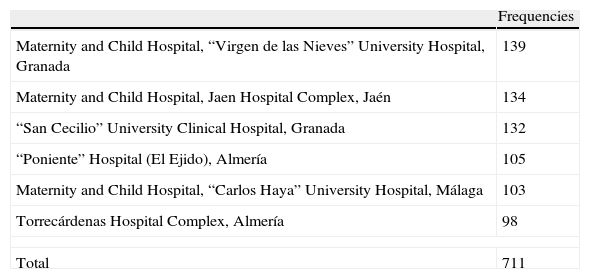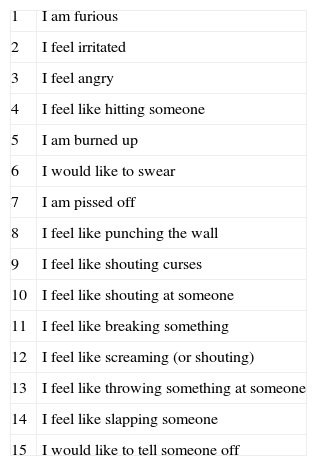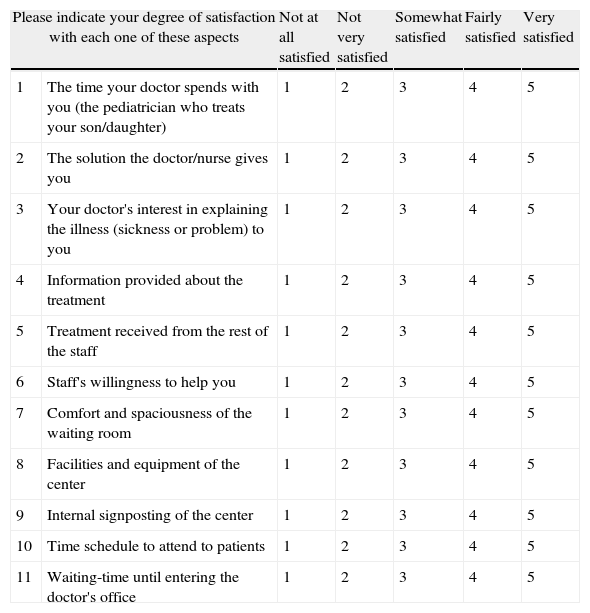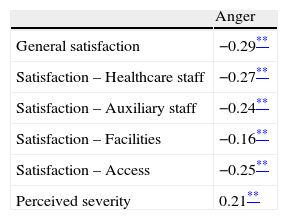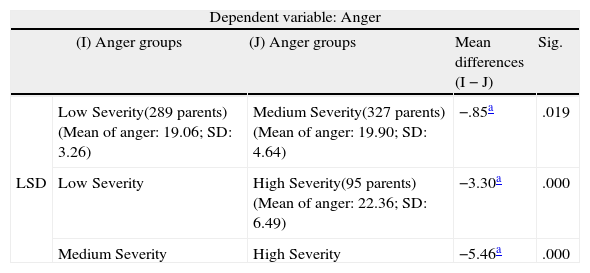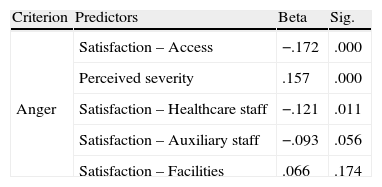Anger in patients and relatives is very frequent in health emergency services and is often associated with aggressiveness and emotional alterations. The aim of the present study is to explore anger in parents while their children are receiving care in paediatric emergency services, seeking the specific dimensions of dissatisfaction that may predict the onset of anger in parents.
Materials and methodsA cross-sectional descriptive study was conduced using a self-report questionnaire in 711 parents of children seen in paediatric emergency departments. The self-report questionnaires used were the State-Trait Anger Expression Inventory-2 (STAXI-2) and the Satisfaction with Healthcare Services Scale. The statistical analysis included descriptive, correlational, variance and multiple linear regression models.
ResultsA total of 53 parents (7.5%) showed a moderate or high anger level. The mean score for satisfaction was 37.12 (SD=7.33). It was found that higher levels of overall satisfaction were significantly associated with lower levels of anger (r=−.29, p=.00). Among the variables studied, dissatisfaction with access to the service (β=−.172, p=.00), with the healthcare staff (β=−.121, p=.01), and perceived severity of the child's health status (β=.157, p=.00) predicted higher levels of anger.
ConclusionsOn the basis of our results, it is important to continue working to substantially improve access for patients and their families to the emergency department, as well as the information and communication process with the healthcare staff should be included in intervention initiatives.
La ira en pacientes y familiares durante su estancia en servicios de urgencias ha merecido la atención de investigadores desde hace tiempo. El objetivo del presente estudio es explorar la ira de los padres durante la atención a sus hijos en servicios de urgencias pediátricas, sondeando dimensiones específicas de insatisfacción que pueden predecir la aparición de ira.
Material y métodosSe trata de un estudio descriptivo transversal mediante autoinforme en 711 progenitores de niños atendidos en servicios de urgencias de pediatría. Los instrumentos utilizados fueron el Inventario de Expresión de Ira Estado-Rasgo -2 (STAXI-2) y la Escala de Satisfacción con los Servicios Sanitarios. Los análisis estadísticos incluyeron análisis descriptivos, correlaciónales, de varianza y de regresión lineal múltiple.
ResultadosUn total de 53 progenitores (7.5%) mostraron niveles de ira altos o medios. La puntuación media en satisfacción fue 37.12 (SD=7.33). Se encontró que mayores niveles de satisfacción general se asociaron significativamente a menores niveles de ira (r=-.29, p=.00). Entre las variables estudiadas, una menor satisfacción con el acceso al servicio (β=-.172, p=.00) y con el personal sanitario (β=-.121, p=.01) y una mayor gravedad percibida del estado de salud del menor (β=.157, p=.00), predijeron mayores niveles de ira.
ConclusionesEs importante continuar trabajando para mejorar el acceso de los pacientes y sus familiares a los servicios de urgencias, los procesos de información y la comunicación con el personal sanitario, entre otras iniciativas.
Satisfaction with care received in health services has been an object of study and analysis for many years, and it is considered that users’ perception of this care is closely related to the quality, effectiveness, and efficiency of a service.1–3 Satisfaction is difficult to measure, among other things, precisely due to its complexity.4–8
The variables more frequently studied because of their possible association with satisfaction can be grouped into four main dimensions. The first one refers to the care received from the healthcare staff. A second group is related to care received from the remaining personnel (not health personnel). The third group of variables studied is related to the conditions and facilities of the service. Lastly, a fourth group of variables is related to the accessibility to the health services.9 In addition to these four aspects, the severity and the symptomatology presented by the patient have also been studied frequently due to their relationship with satisfaction.
No doubt, the set of variables that has received the most attention is included in the first category of variables. Among them, the patient–doctor relationship, for example, has been considered essential for patient satisfaction.10,11 Thus, when problems or difficulties arise in aspects such as communication with the healthcare staff, information received during the healthcare process, coordination, the participation of the family in assistential issues and in decision-making, the levels of user satisfaction are clearly lower.11–15
With regard to the second and third groups of variables, there have been many studies of variables, such as relationships with the staff, the physical conditions, and other organizational issues in specific hospital units, with low levels of satisfaction associated with poor ratings of these variables.2,16,17
With regard to the fourth group of variables, when accessibility to the service is deficient, the waiting times are long, the office hours limited, with long intervals before obtaining the results of diagnostic tests or specific interventions, long distances from the users’ home, etc., the users’ levels of satisfaction decrease significantly.14,18
Lastly, with regard to the severity of the disease, some investigators have found that higher severity of the disease is associated with a higher level of satisfaction with the care received.14
In the specific case of paediatric care, the parents usually present high levels of emotional alteration such as fear, anxiety, or stress,21,22 which could be associated with irritation, anger and fury. Although some authors have related satisfaction with diverse emotional alterations in the healthcare setting – for example, stress and/or anxiety is associated with lower levels of satisfaction19 – few studies have examined the relationship between satisfaction and emotional alteration in paediatric emergency services.
The goals of this investigation are, firstly, to determine the association between satisfaction with healthcare and anger in the parents of children attended to in healthcare emergency services on the one hand, and the association between the parents’ perceived severity of their children's health status and anger, on the other. According to the literature consulted, we expect to find that, at a lower level of satisfaction, there will be higher levels of anger in the parents, and that the more severe the child's situation, the higher the levels of emotional alteration could be and, therefore, of anger.
Secondly, we propose to determine whether different levels of severity in the children could explain diverse levels of anger in the parents. Our hypothesis is that, the higher the child's severity as perceived by the parents, the higher the parents’ levels of anger and annoyance.
Lastly, our third goal aims to determine which dimensions of satisfaction studied can better predict the presence of anger in the parents, also taking into account the minor's severity in this relationship. Our working hypothesis is that low satisfaction with the clinical staff could be one of the variables more closely associated with the presence of anger in the parents.
MethodsThis is a cross-sectional descriptive study using a survey in a sample of randomly selected parents, whose sons/daughters were attended in paediatric emergency services.
ParticipantsThe study was conducted in the paediatric emergency services of 6 hospital centres from the autonomous community of Andalucía, Spain. Table 1 shows the specific participating hospitals and the number of participants for each one.
Participating hospitals and number of participants.
| Frequencies | |
| Maternity and Child Hospital, “Virgen de las Nieves” University Hospital, Granada | 139 |
| Maternity and Child Hospital, Jaen Hospital Complex, Jaén | 134 |
| “San Cecilio” University Clinical Hospital, Granada | 132 |
| “Poniente” Hospital (El Ejido), Almería | 105 |
| Maternity and Child Hospital, “Carlos Haya” University Hospital, Málaga | 103 |
| Torrecárdenas Hospital Complex, Almería | 98 |
| Total | 711 |
These are centres of reference in provincial capitals serving populations of between 150,000 and 500,000 inhabitants. In the paediatric emergency department of all these centres (except in the “Hospital de Poniente”) there are between 2 and 4 paediatric medical specialists and about four residents continuously present. All of them are independent units from general emergencies, with separate waiting rooms.
A total of 711 randomly selected parents participated in the study. The final sample was made up of 275 fathers (38.7%) and 436 mothers (61.3%), aged between 18 and 66 years (mean=35.29, SD=8.30) and the mode=40. With respect to patients, the mean of age was 5.49 (SD=4.11), the range was 0–17 years, and the mode=1 year old. Of these 432 (60.8%) were boys and 279 (39.2%) were girls.
MeasuresDemographic information. Each participant was asked about their age and gender.
To assess the state of anger, we used the subscale “State-Anger” of the State-Trait Anger Expression Inventory-2″ (STAXI-2).20 This inventory is the version adapted to the Spanish population of the “State-Trait Anger Expression Inventory-2”.23 The inventory assesses anger as a state and a trait, among other more complex indicators. As can be seen in Table 2, the state scale used in this study has 15 items that provide a general anger score.
Composition of the subscale “State-Anger” of the State-Trait Anger Expression Inventory-2.
| 1 | I am furious |
| 2 | I feel irritated |
| 3 | I feel angry |
| 4 | I feel like hitting someone |
| 5 | I am burned up |
| 6 | I would like to swear |
| 7 | I am pissed off |
| 8 | I feel like punching the wall |
| 9 | I feel like shouting curses |
| 10 | I feel like shouting at someone |
| 11 | I feel like breaking something |
| 12 | I feel like screaming (or shouting) |
| 13 | I feel like throwing something at someone |
| 14 | I feel like slapping someone |
| 15 | I would like to tell someone off |
Each item is rated on a 4-point Likert-type scale, and it is possible to answer using the following options: 1 (not at all), 2 (Somewhat), 3 (Moderately) or 4 (Very much).
Scores can be obtained in a range of between 15 and 60. With regard to the results and related to women, scores of between 43 and 60 are interpreted as a high level of anger and between 28 and 42 as moderate level. The range 16–27 indicates low level of anger, and a score of 15 implies zero level of anger. For men the interpretive categories vary somewhat. Scores between 41 and 60 involve a high level of anger, between 33 and 40 a moderate level, between 16 and 32 a low level and a score of 15 indicates a level of null anger. In the standard population or “control”, the results indicate that in the case of men the average is 18.15 (SD=5.08), whereas in women the average is somewhat lower, 17.51 (SD=5.00), with no significant differences between men and women (t=1.97, p=0.06).20
The value of Cronbach's alpha for the scale of State Anger in the original validation study of the Spanish version was .89, whereas, in our case, this measure of internal consistency was .82.
In order to assess satisfaction, we used the Satisfaction with Healthcare Services Scale.24 As detailed in Table 3, the scale includes 11 items, each of them rated on a 5-point scale ranging from 1 (Not at all satisfied) to 5 (Completely satisfied).
Composition of the Satisfaction with Healthcare Services Scale.
| Please indicate your degree of satisfaction with each one of these aspects | Not at all satisfied | Not very satisfied | Somewhat satisfied | Fairly satisfied | Very satisfied | |
| 1 | The time your doctor spends with you (the pediatrician who treats your son/daughter) | 1 | 2 | 3 | 4 | 5 |
| 2 | The solution the doctor/nurse gives you | 1 | 2 | 3 | 4 | 5 |
| 3 | Your doctor's interest in explaining the illness (sickness or problem) to you | 1 | 2 | 3 | 4 | 5 |
| 4 | Information provided about the treatment | 1 | 2 | 3 | 4 | 5 |
| 5 | Treatment received from the rest of the staff | 1 | 2 | 3 | 4 | 5 |
| 6 | Staff's willingness to help you | 1 | 2 | 3 | 4 | 5 |
| 7 | Comfort and spaciousness of the waiting room | 1 | 2 | 3 | 4 | 5 |
| 8 | Facilities and equipment of the center | 1 | 2 | 3 | 4 | 5 |
| 9 | Internal signposting of the center | 1 | 2 | 3 | 4 | 5 |
| 10 | Time schedule to attend to patients | 1 | 2 | 3 | 4 | 5 |
| 11 | Waiting-time until entering the doctor's office | 1 | 2 | 3 | 4 | 5 |
The scale has four subscales, which determine the patient's level of satisfaction with the healthcare staff, with the auxiliary staff, with the facilities of the health centre, and with access to and functioning of the services.
The general satisfaction scores can be obtained in a range of between 11 and 55, 22 being the midpoint of the possible score. Scores above 22 imply medium-high or high levels of satisfaction.
The psychometric characteristics of the original scale are acceptable, with Cronbach's alpha scores between .80 and .82 for global expression, and between .59 and .89 for the specific dimensions.24 In our study, alpha was .91.
We asked all the parents about their perception of the severity of the health situation of their child, which could be low, medium, or high severity. The number of subjects in each category is shown in Table 5.
ProcedureFirstly, we proceeded to contact the authorities of the Andalusian Health Service for authorization to obtain information on health centres in the provinces of eastern Andalusia. In all the centres, we also obtained approval from the ethics and research committees for the development of our investigation.
The application of the questionnaires was conducted by experienced interviewers hired by the research team. The evaluators went to the centres and proceeded to seek the cooperation of the families after they had been treated at the paediatric emergency departments. The investigation took place in the first semester of 2012, avoiding summer time because of its population changes.
All the families were informed about the goals of the investigation, the anonymous nature of their participation, and the confidentiality of their responses. They were also informed about the possibility of dropping out of the process of responding to the questionnaires at any time, and they were requested to sign an informed consent form. In order to standardize data collection, all the parents were assessed separately in the waiting room of the paediatric emergency department or in a room provided by the health centre, after the child had received healthcare attention, while they were waiting for the medical discharge or immediately after having received it. The questionnaires were administered individually.
Inclusion criteria were that the child had been attended in the paediatric emergency services at least 5h earlier, voluntary participation in the study (with signed informed consent), and the child had not yet been discarded. Exclusion criteria were specific circumstances that dissuaded, impaired, or prevented completing the assessment instruments, such as the presence of difficulties in the child that advised against the parents’ participation, mental disability, inadequate educational level to understand the questionnaires, very poor comprehension of the Spanish language, or not signing the informed consent.
Data analysisTo analyze the data, in addition to the pertinent descriptive and frequency analyses, we conducted Pearson's correlational analysis, analysis of variance, and multiple linear regression analysis.
ResultsDescriptive analysisTo know the percentage of subjects expressing a high level of anger, specific gender based criteria were used. Thus, 21 parents expressed a moderate or high anger level, reaching a highest score of 33. With respect to mothers, 32 of them achieved an equal or higher than 28 score, expressing thus a moderate or high anger level. Therefore, a total of 53 parents (7.5%) achieved moderate or high anger level while the rest, 658 (92.5%) expressed low or nonexistent level of anger.
Regarding satisfaction, overall average achieved by the sample was 37.12 (SD=7.33). For the different subscales the mean and standard deviations were: satisfaction with health personnel=14.40 (SD=3.18), satisfaction with support staff=7 (SD=1.73), satisfaction with the physical conditions=9.9 (SD=2.58) and satisfaction with service access=5.81 (SD=1.9). In the general expression of satisfaction and in the specific subscales, the average score was high or medium high.
Association of variablesFirstly, we conducted a bivariate correlation analysis to determine the possible association between the global expression of anger, on the one hand, and the different dimensions of satisfaction considered, on the other. We also calculated the correlation between anger and the severity level of the child's health status as perceived by the parent. The results can be seen in Table 4.
Correlations between anger and the diverse expressions of satisfaction and perceived severity.
Our results show a significant and negative association between satisfaction and anger during paediatric emergency healthcare. Thus, we found a significant positive association between higher anger and (a) lower global satisfaction level, (b) lower levels of the diverse dimensions of satisfaction: with the healthcare staff, with the auxiliary staff, with the facilities of the health centre, and with access to and functioning of the services, and lastly, (c) higher levels of child's severity perceived by the parents.
Analysis of varianceIn accordance with our second goal and to determine differences in parents’ anger as function of their subjective perception of their child's health status severity, we carried out an ANOVA.
The ANOVA revealed significant differences in anger as a function of the child's perceived severity, F(2, 708)=19.67, p<.00, with a tendency to a generalized increase in anger when the perceived severity was higher.
The multiple comparison test carried out showed significant differences between the three groups of subjects (child's low, medium, and high perceived severity), as shown in Table 5.
Multiple comparisons. Anger differences as a function of perceived severity.
| Dependent variable: Anger | ||||
| (I) Anger groups | (J) Anger groups | Mean differences (I−J) | Sig. | |
| LSD | Low Severity(289 parents)(Mean of anger: 19.06; SD: 3.26) | Medium Severity(327 parents)(Mean of anger: 19.90; SD: 4.64) | −.85a | .019 |
| Low Severity | High Severity(95 parents)(Mean of anger: 22.36; SD: 6.49) | −3.30a | .000 | |
| Medium Severity | High Severity | −5.46a | .000 | |
LSD: least significant difference.
With regard to our third goal, we conducted a linear regression analysis considering the dependent variable as the level of general anger, and as predictor variables the diverse specific indicators of satisfaction and the severity of the illness perceived by the parents. The results are presented in Table 6.
Multiple regression analysis: anger, satisfaction and perceived severity in child's emergency healthcare attention.
| Criterion | Predictors | Beta | Sig. |
| Anger | Satisfaction – Access | −.172 | .000 |
| Perceived severity | .157 | .000 | |
| Satisfaction – Healthcare staff | −.121 | .011 | |
| Satisfaction – Auxiliary staff | −.093 | .056 | |
| Satisfaction – Facilities | .066 | .174 |
F(5, 705)=19.50, p<.00.
R=.35, R2=.12, adjusted R2=.12, SE=4.30.
The model explained 12% of the variability of global anger, according to the adjusted R2. Our results indicated that not all the predictors introduced in the model predict the parents’ anger. Of all the variables considered, satisfaction with access to the service, followed by the perceived severity, reached the highest beta values.
DiscussionIn our results, we observed that the lower the paternal satisfaction with the care received in emergency services the higher the levels of annoyance and anger. This result is repeated both in global satisfaction and in specific satisfaction in the four dimensions considered. When focusing on the severity of the child's disease, we also clearly found a parallel tendency of higher levels of anger coinciding with higher perceived severity of the child. These results agree with those found in other studies that related to greater emotional alteration (for example stress, or anxiety) with higher levels of perceived severity by the parents.21
Perhaps the most relevant result of this study derives from the regression analysis carried out. Of all the aspects considered, low satisfaction with access to the paediatric emergency services seems to be the best predictor of the presence of anger. This variable is associated with diverse aspects that vary from the time it takes to travel from the family home to the health centre, the time until they are attended to after arriving at the emergency service, or more indirect aspects, such as the easy access with a private vehicle, etc. In fact, the waiting times – whether to receive attention, to obtain information or the result of medical tests – have been the object of study for some time, due to their importance in patient satisfaction or as a source of parents’ stress and emotional alteration.18,25–27
The next variable that best predicts satisfaction is perceived severity. This result – which is along the lines of the results of the correlation and the analysis of variance – indicates that parents’ perception of their children's severity of disease is one of the variables that best predict anger. This result deserves more attention in future research, because the effect of severity is probably mediated by contextual variables, the care received, or some other kind of emotional alteration, such as, for example anxiety or stress.14,21 Moreover, future studies should use a more robust indicator of the patient's severity, for example, that is provided by medical specialists or obtained by means of a reliable assessment instrument. In our case, the indicator we used, although it provides a subjective, direct, and personal rating by the parents, has the limitation of not being a robust measurement.
Regarding other indicators of satisfaction, satisfaction with the performance of the medical and health personnel has also been shown to be relevant. Thus, low satisfaction with these aspects doubtlessly predicts anger in the parents. As reported in other studies, when referring to stressors during paediatric care,21,26 some aspects, for example, the care received, communication with the paediatricians and other health personnel, and access to information are clearly associated with emotional alteration and, in our case, when they are deficient, to higher levels of anger.
Lastly, of the variables studied, satisfaction with the non-medical personnel and satisfaction with the facilities, the equipment, the waiting room, and other physical aspects of the healthcare setting were the worst predictors of the onset of parents’ anger. In other studies of diverse health services, it was found that issues such as comfort or the facilities were associated with good levels of general user satisfaction5,12,28; however according to our data, these variables did not predict anger in the population under study. Perhaps the relevance of these aspects is lower in our specific case, where the interaction with these professionals tends to be scarce and brief.
Limitations of the study include some characteristics of the sample with which we worked through the implications this may have. Our sample has a low percentage of parents with moderate or high anger scores. This could subtract clinical relevance from our study and suggested other studies that may focus on specific samples of parents with high levels of anger in these circumstances. It would also have been of interest to consider variables such as for example clinical severity of patients or waiting times because of the implications that they could have. Not having taken it into account requires that our results should be understood with caution and involves aspects of interest for future research.
To conclude, on the basis of our results it seems evident that in order to reduce the levels of parents’ anger in paediatric emergency services, accessibility to the service, interpersonal interaction, as well as some aspects of the professionals’ work should be taken into account.29 Aspects like the access to receive attention or communication with the personnel seems to be among the most important, like in primary care and paediatric hospital services. With regard to the work of the clinical staff and applied aspects, it may be appropriate to promote efforts aimed at improving communication, with initiatives such as the continuity of the same informer throughout the entire healthcare process, parents’ access to comprehensible health information, participation of the family in the assistential process and decision-making, or rapid and efficient attention to the patient's symptomatology and distress.
Conflict of interestThe authors declare no conflict of interest.
This study is part of a research project funded by the Regional Ministry of Health. Regional Government of Andalusia. Spain. Project code (grant number): 0142/08. (The Sponsor has not played any part in the design, analysis, data interpretation, writing of the article, or in the decision to submit the work for publication. The authors are completely independent from the Sponsor.)
Please cite this article as: Fernández-Castillo A, Vílchez-Lara MJ. Factores desencadenantes de insatisfacción e ira en padres de niños atendidos en servicios de urgencias pediátricos. An Pediatr (Barc). 2015;82:12–18.


